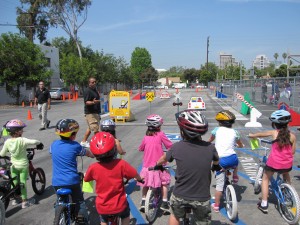From childhood, we are constantly being taught the rules of the road. We’ve seen siblings get speeding tickets, heard parents honk at discourteous drivers, and read about tragedies caused by drunk and distracted driving. By the time we are old enough to enroll in a driver’s education course and apply for a driver’s license, we are already familiar with driving laws, safe practices and etiquette.

Unfortunately, most of this experience only teaches us how to use our streets as motorists. Those who roll out of their driveways for the first time on two wheels confront a host of issues they never considered previously:
The problem is the lack of accessible, informed and comprehensive education regarding the rights and responsibilities of bicyclists. Few of us receive adequate instruction before getting behind the handlebars or the steering wheel and navigating the streets of Los Angeles. Schools rarely offer bicycling courses by certified instructors. Those who teach drivers’ education courses only briefly refer to bicyclists, instead of informing students of bicyclists’equal right to use the road.
To complicate matters, the minimal bicycle education we do receive is often erroneous -- especially when it comes from friends and authority figures who lack training and personal experience on a bicycle. Parents, teachers and police officers are wise to teach children to wear helmets, use lights at night, stop at red lights and look “left, right, left” before crossing a street. But counseling a bicyclist to “stay on the sidewalk” or “stay as far to the right as possible” is misguided. Door zones and blind spots are paved with good intentions.
Our first step must be to educate our youth. Because they are eager to learn, children are excellent candidates to learn bicycling basics. Friends, siblings and parents can usually teach steering and braking on their own. But beyond this, the help of a trained bicycle instructor is invaluable.
A bicycle “rodeo” is an effective and engaging way to educate young people. At a rodeo, a certified instructor assists children as they fit helmets, learn hand signals, navigate traffic-cone courses and practice balancing through figure-eights. Any community center that regularly hosts groups of children, such as a school, church, synagogue or youth sports league, can readily organize a rodeo.
When not reinforced on a regular basis, even basic skills can be forgotten quickly. Therefore, it is important that those who are new to bicycling continue to review the basics they’ve learned, such as the importance of obeying traffic signals, traveling on the right side of the road and using helmets and lights.
- Additionally, bicyclists should know the importance of:
- Planning routes to avoid unsafe stretches of road
- Using hand signals
- Taking the lane to discourage unsafe passing
- Making a “box turn” by using crosswalks to turn left at difficult intersections
- Maintaining predictable lane position
As I encounter too often in my practice, even the most prudent bicyclists may be threatened or injured by motorists who do not respect bicyclists’ equal right to the road. After all, helmets cannot shield us from the indignity inflicted by an irate driver’s honking, and hand signals cannot compel an aggressive motorist to yield the right-of-way.
So, effective bicycle education must also include measures to inform motorists of their responsibility to share the road with bicyclists. This means more than a multiple-choice question on an exam. It means additional public outreach, more sharrows painted on streets, and publicized traffic enforcement operations targeting drivers who park in or obstruct bicycle lanes.
In particular, these methods should aim to remind motorists of a couple key points:
- “Taking the lane” is a bicyclist’s way of signaling that the lane is too narrow for a motorist to try to squeeze past. Change lanes to safely pass.
- Bicyclists often travel faster than motorists expect. Exercise great caution before turning into a bicyclist’s path. Do not attempt to pass a bicyclist when approaching stop signs or red lights, or when preparing to turn right.
When motorists and bicyclists disregard their rights and responsibilities, safety and civility on our roads suffer. Proper education, widely accessible to those on two wheels and four, can help everyone understand the needs of other road users.
(The law firm of Gordon, Edelstein, Krepack, Grant, Felton & Goldstein, LLP is dedicated to protecting the rights of those who have suffered serious injuries on or off the job. Partner Howard Krepack, an avid bicyclist, leads the firm’s bicycle accident practice. For more information about our firm, call us at 213-739-7000 or visit our website: www.geklaw.com.)






